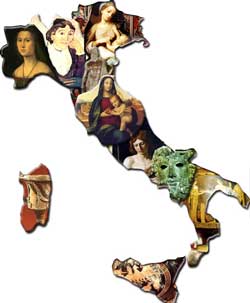THE SCIENTIFIC HERITAGE
With Galen, an ancient Greek physician of the third century, Science was born in Italy, as it is understood today. His work influenced European science for a thousand years.
With the scientific revolution in the sixteenth century, modern science began to be established. During this period, in Italy Galileo Galilei developed the bases of scientific methodology, which emphasised experiment and reason. The Italian contribution in modern times has been no less important, with such people as Luigi Galvani and Alessandro Volta, known for their pioneering studies on electricity, Antonio Pacinotti, who invented the dynamo, and Antonio Meucci, who invented the telephone. There have also been many illustrious Italian Nobel Prize winners, such as Enrico Fermi and Guglielmo Marconi in physics, Giulio Natta, who was one of the fathers of industrial chemistry, and Camillo Golgi and Rita Levi-Montalcini for their contributions to medicine.
THE ARTISTIC HERITAGE
Italy’s artistic heritage embraces all sectors, from architecture to humanities, from music to industrial design. Once the center of the vast Roman empire, from which it has inherited an enormous archaeological, cultural and literary heritage, the Italian peninsula was the focal point of Medieval and Renaissance humanism. The development of architecture has left an inestimable architectural heritage in Italy, characterized in every age by a unique and inimitable style. The list of famous Italian artists is long and includes Giotto, Botticelli, Leonardo, Michelangelo, Tintoretto and Caravaggio. Famous musicians such as Verdi and Puccini were also born in Italy, as was the motion picture director Federico Fellini. Illustrious persons of the calibre of Machiavelli, Dante, Leonardo and Galileo have contributed to forging European political thought, philosophy and arts.
In more recent times, significant Italian literary figures include Giosuè Carducci, Eugenio Montale, Grazie Deledda, Luigi Pirandello, Salvatore Quasimodo and Dario Fo, all winners of the Nobel Prize for Literature.
A strong impulse was also given to the country in the twentieth century by industrial design and fashion. Art and music are surely the spheres of excellence of Italian culture that are best known throughout the world. Art had its highest and most distinguished expression during the period running from the fifteenth to the sixteenth century and beyond, periods known as the Renaissance and Baroque. But the country’s long history, and the numerous periods of wealth that it has crossed, have left as their heritage examples of art of noteworthy beauty and prestige throughout the various ages and civilizations. They have rendered Italy unique in the world in terms of the variety of its artistic treasures and for their capillary spread over the territory. Italy boasts the largest number of UNESCO heritage sites, 47 sites representing sixty percent of the entire worldwide cultural heritage. It is the fifth most visited country in the world.

